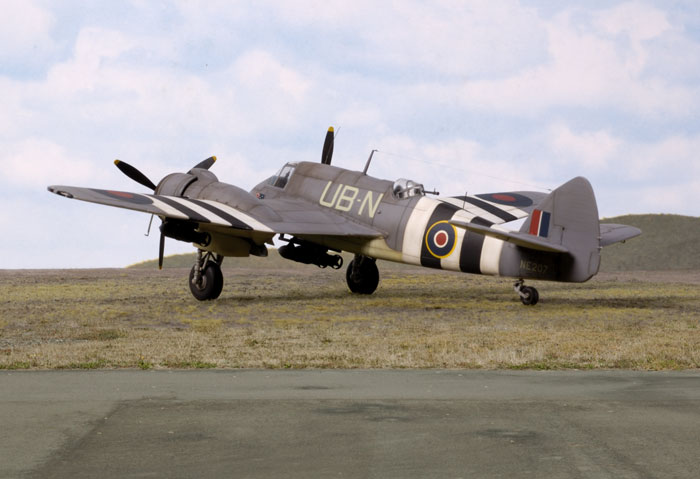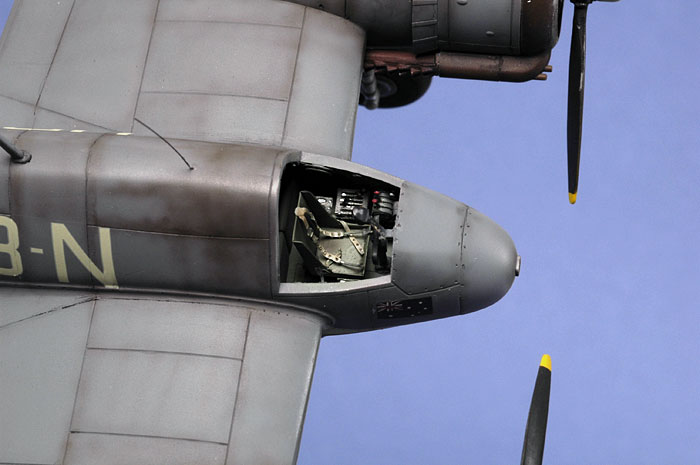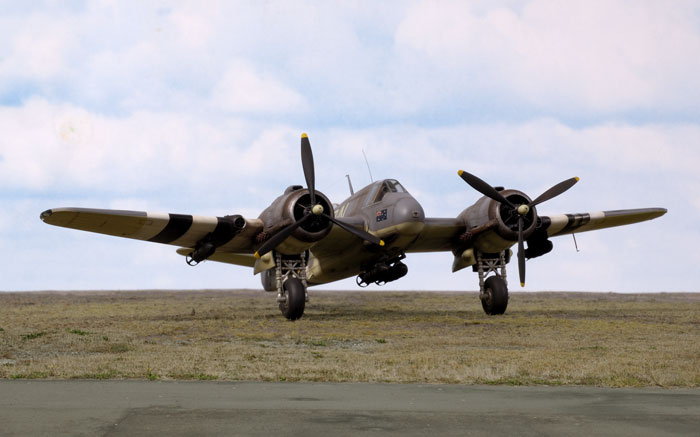|
Hasegawa's
1/72 scale
Beaufighter Mk.X
by Chris Wauchop
|

|
|
Bristol Beaufighter Mk.X |
images by Brett Green

Hasegawa's 1/72 scale Beaufighters are available online from
Squadron.com
Hasegawa's 1/72 scale Beaufighter in the box
Airfix and Frog released their small scale Beaufighter kits in the
1960s. They are both typical products of their era with raised panel
lines, crude clear parts and seriously wanting in detail.
More recently, the 1/72 scale High Planes limited run kit certainly
added much needed detail and surface features are petite, but its
low-pressure injection mouldings do require the hand of a more
experienced modeller.
Hasegawa added their Beaufighter family during the 1990s. This
remains the best and most buildable Beaufighter in small scale.
Hasegawa initially released a Beaufighter Mk.VI, followed by an
Australian DAP Beaufighter Mk.21 and then the TF. Mk.X.

The kits each comprise over 120 parts in grey styrene and eleven
parts in clear. Surface detail is crisp and very finely recessed. Some
raised structures are also present where applicable.
Hasegawa's Beaufighters contain structural detail in the
undercarriage bays and subtly flattened one piece main wheels. A choice
of tail wheels and observer's blisters are included, as is ordnance.
Cockpit detail is very sparse though, comprising only a seat and a blank
instrument panel with a softly printed decal for dials. The only other
disappointing aspect of the kit is the severely understated "hedgehog"
exhausts.
Apart from these minor criticisms, this is an excellent kit. In
several respects it is, in our opinion, superior to the 1/48 scale
Tamiya Beaufighter.
Hasegawa also released a Limited Edition version as kit number CP
119. This special version supplied plastic bombs and white metal
hedgehog exhausts. The metal parts were a vast improvement over the
original kit parts.
This is Hasegawa's 1/72 scale Limited Edition kit number CP 119,
"Beaufighter Mk.X with Bombs" finished in the markings of 455
Squadron RAAF. This aircraft was based in Scotland.
The kit went together with no problems at all. In fact, the fit of
all the parts was just about perfect.
Eduard's detail set 72 275 was used. Although this set was designed
for a Mk.VI Beau, most of the set was still used on this variant.
The cockpit interior was especially nice, including a replacement
seat and harness, side consoles with quadrants and handles, an authentic
instrument panel with printed acetate dials, plus more details aft of
the seat.

Eduard also supplied some exterior details, including the rings for
the rear of the bombs and cowling braces.
The only scratch built extras were whip antennas from fine wire,
brake lines down one side of each undercarriage leg and a relief tube
(at least that is what we think it is) on the bottom of the starboard
side from fine copper tube.
Chris started to build new hedgehog exhausts using tiny triangles of
plastic on a tapered plastic rod. When he had finished the hard work on
one of these, he realised that superior metal replacements were in the
box. There was no mention of these in the instructions. Chris decided to
use the metal exhausts instead of repeating his scratchbuilding efforts
on the second exhaust!
Metal crosshair wire was used for the main antenna wire.

The fit of the clear parts was so good that no glue was required for
the canopy. It almost snapped into place, and now can be removed any
time the owner wants to admire all that extra effort in the front
office.
 The
model was painted using the metal bodied Testor Aztek airbrush fitted
with the fine tan-coloured tip. The
model was painted using the metal bodied Testor Aztek airbrush fitted
with the fine tan-coloured tip.
The lower surfaces were painted using Gunze Sangyo H74 Sky.
Upper surfaces are Gunze Sangyo H75 Dark Sea Grey.
The engine cowling rings are painted using Tamya XF-64 Red Brown with
a dash of XF-1 Flat Black. Silver chipping on the front of the rings was
achieved using a silver "Prismacolor" pencil from Sanford.

Panel lines and various dirty patches on the fuselage using were
emphasized using the thin Tamiya Red Brown / Flat Black mix thinned
around 80% with alcohol.
Kit decals were used with the aid of Gunze's Mr Mark Setter and Mr
Mark Softer. Hasegawa has helpfully supplied the black sections of the
invasion stripes to apply over painted white bands. All the decals
performed beautifully.
The final finish was a coat of Polly Scale Acrylic Flat.
Following the flat coat, the square lens of the strike camera on the
nose of the aircraft was painted with a dab of Micro Krystal Kleer.
The model was photographed in HyperScale's studio using a Nikon D70
digital SLR. Illumination was via two studio flash units - one Bowens 250
and a generic 100 flash - on stands and illuminating from a high 45º
angle from each side of the front of the photography table.
The camera was fitted with a Micro
Nikkor 60mm lens.
ISO was set to 250, and the manual
shooting settings were 1/100 of a second at f.29. The high aperture
ensures good depth of field.

The model was placed on a base of static
grass in front of an enlarged photograph of sky.
For the photos with the extended grass
and tarmac foreground, the model photo was merged with a photograph taken
at Bankstown Airport in Sydney's south-western suburbs. The colour and tone of the grass in the airport photo and the
model photo matched with Photoshop's hue and saturation tool. The demarcation
between the model static grass and the real grass in the foreground was
merged using the Clone Stamp tool.
A number of additional photos were taken
on plain blue cardboard.
All of the images were optimized
(brightness and contrast) in Photoshop CS, resized to 700 pixels in
width and saved as 75 dpi .jpg files using Photoshop's "Save for the
Web" option.
Click on the thumbnails
below to view larger images:
[../../photogallery/photo00010742/real.htm]
Model by Chris Wauchop
Text Copyright © 2007 by Chris Wauchop and
Brett Green
Images Copyright © 2007 by
Brett Green
Page Created 02 July, 2007
Last Updated 24 December, 2007
Back to HyperScale
Main Page
|
Home
| What's New |
Features |
Gallery |
Reviews |
Reference |
Forum |